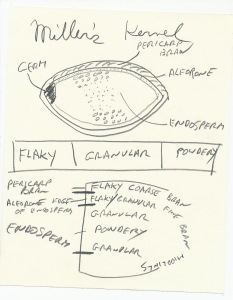
Stone milling is the art of grinding grain into a meal, and then through sifting and re-grinding (and re-sifting), refining the product into the quality flour one wants for the finished product. While sifting determines the final quality of flour, the ratios of what is produced (and thus profit) depends heavily on the precision with which the miller creates the feedstock to be sifted. Millers were constantly feeling the flour that came out of the mill. Millers did this so much they deformed their thumbs — thus there is a fish that is called the Millers Thumb, the European Bullhead (Cottus gobo). Judging by an image of the fish, the miller’s thumb was widened at the fleshy pad — presumably with a thick callous.
The British artist, John Constable’s father was a miller. Following is, apparently, Constable himself, explaining how millers use their thumb. This is from Cassell’s Popular Natural History, Volume II, 1854, p. 103.
The father of the late John Constable, Esq., it.A., was a miller, and our eminent English painter described to Mr. Yarrell this singular form of the human thumb.
“It is well known,” he says, “that all the science and tact of a miller is directed so to regulate the machinery of his mill, that the meal produced shall be of the most valuable description that the operation of grinding will permit, when performed under the most advantageous circumstances. His profit or his loss, even his fortune or his ruin, depend upon the exact adjustment of all the various parts of the machinery in operation. The miller’s ear is constantly directed to the note made by the runningstone in its circular course over the bed-stone, the exact parallelism of their two surfaces, indicated by a particular sound, being a matter of the first consequenoe; and his hand is as constantly placed under the meal-spout, to ascertain by actual contact tho character and qualities of the meal produced.
The thumb, by a particular movement, spreads the sample over the fingers; the thumb is the gauge of the value of the produce, and hence has arisen the sayings of ‘Worth a miller’s tlmnib,’ and ‘An honest miller hath a golden thumb,’ in reference to the amount of the profit that is the reward of his skill. By this incessant action of the miller’s thumb, a peculiarity in its form is produced, which is said to resemble exactly the shape of the head of the fish constantly found in the mill-stream, and is obtained for it the name of the Miller’s Thumb, which occurs in the comedy of ‘Wit at Several Weapons,’ by Beaumont and Fletcher, and also in Merrett’s ‘Pinax.’